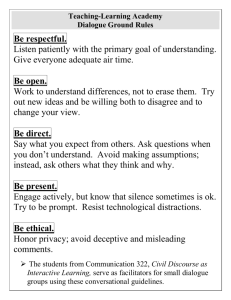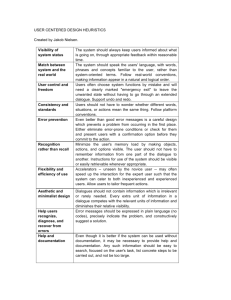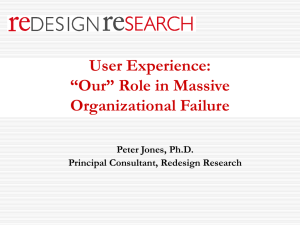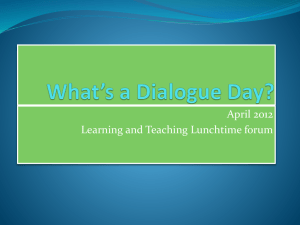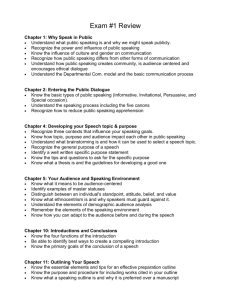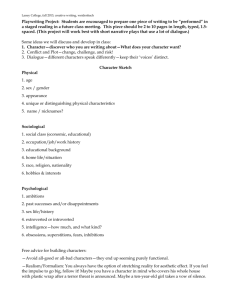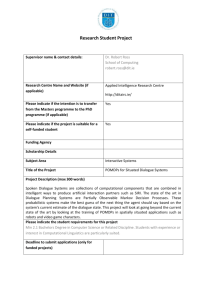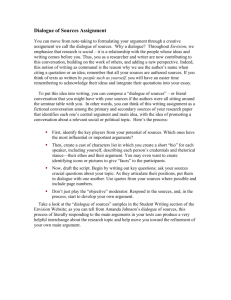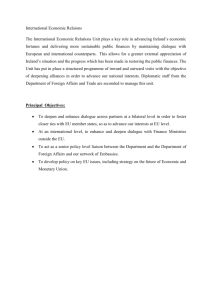Document 9902926
advertisement
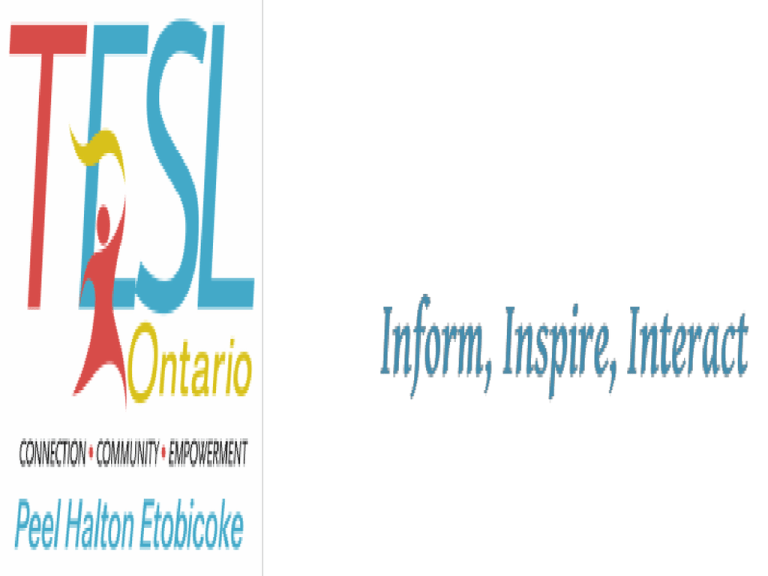
Using Dialogue to Help Students Develop Argumentative Essay Nermine Abd Elkader, PHD ESL Professor Sheridan College Overview 1. EAP students: population, expectations, and needs 2. Teaching argumentative writing dialogically vs. the traditional formalist approach 3. Dialogic teaching vs. class discussion 4. Practice: how to run a dialogic writing class? Our EAP student Population • An EAP student is at an advanced stage of English language proficiency • According to Canadian Language Benchmark, such students can: “Understand an adequate range of complex texts in some unpredictable contexts and on some unfamiliar topics” (Centre for Canadian Language Benchmarks, 2012, p. 98) • “Write formal and informal texts of some complexity for an adequate range of purposes and tasks in routine but demanding situations” (Centre for Canadian Language Benchmarks, 2012, p. 134) Expectations (Garbe and Zhang, 2013, p. 12) • In an academic setting but also applicable to many professional settings. • Taking notes from a text • Summarizing text information • Combining information from multiple text sources in a synthesis task • Comparing multiple points of view from written texts and producing a critical synthesis • Writing an extended research paper or literature review • Responding to assigned texts (summary and then critique) Challenges Ferris (2009) outlined nine key issues that challenge L2 students in academic settings in comparison with their L1 counterparts : • Limited experience with extensive reading and/or application of information from reading for writing tasks • Limited vocabulary knowledge in comparison with L1 students • Limited grammatical accuracy • Differing motivations for being in a classroom requiring L2 reading/writing tasks • A relative lack of tacit knowledge about how L2 texts are organized and how they should be organized while writing (i.e. L2 intuitive knowledge and extensive practice is largely missing) • Less L2 cultural and background knowledge to draw on (cf. Garbe & Zhang, 2013, p. 11) The Shortcomings of the Formalist Approach • Five paragraph argumentative essay- Taking a stand; counterargument and rebuttal • Encourages a polarized view that might not be realistic in an academic context, or in the context of family, citizenship, and/or work ( Juzwik, Borsheim-Black, Caughlan, & Heintz, 2013) • Might erroneously convey the message that personal opinion is more important than correctly interpreting and synthesizing information from research and experts’ opinion (Spark,1997). • Emphasizes norms rather than creativity What’s the Dialogic Method of Teaching Argument? a) Guided by students’ interest (Grube, 1981) b) Does not have an end; dialogue is the end (Juzwik et al., 2013) c) Dialogue is a free and democratic way of interacting with and among students. It helps teachers to be learners and learners to be teachers > emphasizing the skills of 21st century literacies. For example: comments on online news, articles, and youtube videos. • Emphasis on audience, purpose, and logical reasoning (Juzwik et al., 2013) • An emphasis on cultural and background knowledge without which the other’s viewpoint and evidence cannot be evaluated (Garbe & Zhang, 2013) • As opposed to the traditional class discussion method with its focus on the teacher as the initiator , dialogue represents a journey where the destination is not foreknown but rather unfolds (Sidorkin, 1999) How to Dialogue? • Dialogic provocation (yours/the students) • Community of Learners (students learning from one another-different abilities, different knowledge, background, histories, experiences) • Internally persuasive discourse (ideas are tested and are forever testable) -> language used, cultural references, tone. Putting it into Practice 1. On your index cards: write few sentences that describe your experience with students’ loans, or any type of loans -> do you approve/disapprove of the idea of loans? Why? Why not?) 2. Share with the person next to you. 3. Read the article “Student Loans”. As you read, write in the margin, some ideas that might have surprised you in a positive or a negative way. Dialoguing about “Student Loans” Agree Mention evidence Appealing to personal experience or immediate needs Disagree Writer’s assumptions and beliefs Political stance- personal experience Use of convincing language Tone and subjectivity Using Templates to Compare Texts • On your index card, try to give a simple answer to the following question • “Who is responsible for the environmental crisis?” • Use the template to provide evidence for or against your opinion from the articles distributed in class. • Alternatively, you can refute the evidence provided by these articles to strengthen your own opinion • Discuss with the group. Did any of your views change? In what way? Wrapping it Up • The dialogue continues beyond the classroom; web blogs, online forum, commenting on news and videos. • Dialogue can also be conducted informally and thus highlighting the difference between academic language and everyday language. https://www.youtube.com/watch?v=byaMd_P NyIY Wrapping it Up “I do see this flaws in Disney, and I am not a fan of Disney. I pretty much ignore most new Disney movies that come out. However, many of these movies are based on classic fairy tales...they are not new stories invented by Disney. Blame the cultures that created the fairy tales if you don't like the stories. As for black characters, um, they have a black princess now..from that frog movie. I hated the movie, but she does exist. They also have an Asian princess (Mulan), plus Jasmine and Pocohontas for "brown" princesses. I like old Disney (Cinderella, Aladdin, Fantasia), but Beauty and the Beast has always been one of my favorite fairy tales.” (Andrea B, youtube) References Centre for Canadian Language Benchmarks. (2012). Canadian Language Benchmarks: English as a Second Language for Adults. from http://www.cic.gc.ca/english/pdf/pub/languagebenchmarks.pdf Garbe, W, & Zhang, C. (2013). Reading and writing together: A critical component of English for Academic Purposes teaching and learning TESOL Journal, 4(1), 9- 24. Grube, G.M.A (1981). Plato. Indianapolis, IN: Hackett Publishing Company. Juzwik, M., Borsheim-Black, C., Caughlan, S., & Heintz, A. (2013). Inspiring dialogue: Talking to learn in the English classroom. New York, NY: Teachers College Press. Sidorkin, A. M. (1999). Beyond discourse: Education, the self, and dialogue. Albany, N.Y.: State University of New York Press. Thank You
